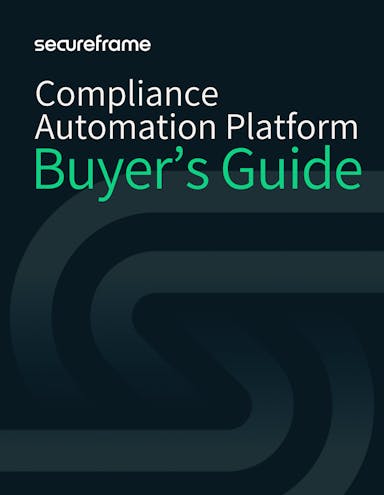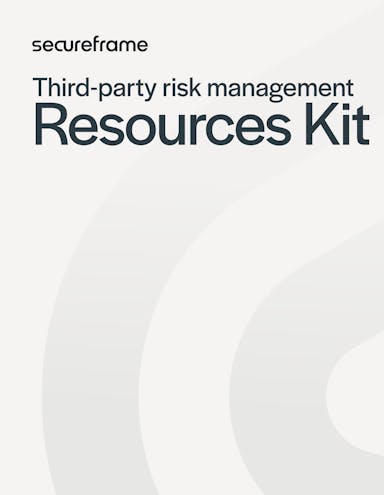
8 Automated Security Workflows that Reduce Costs and Complexity
Emily Bonnie
Senior Content Marketing Manager
Rob Gutierrez
Senior Cybersecurity and Compliance Manager, CISA, CCSK, CMMC RP
Limited resources is one of the most significant and widespread challenges of building and managing a security and compliance program. 58% of security and IT professionals say they need larger compliance budgets — yet scarce resources are often wasted on manual tasks like tracking risks and remediation tasks in spreadsheets, gathering and organizing audit evidence in screenshots and shared drives, and completing lengthy and repetitive security questionnaires.
What’s more, these tasks aren’t one and done — they have to be repeated again and again to maintain compliance and prove a strong security posture to external stakeholders. All of this drives up the costs and complexities of managing a security and compliance program over time.
Automating these manual processes can significantly reduce human error, streamline audit processes, scale to meet increasingly complex regulatory demands, and ensure that security teams and compliance officers can focus on critical threat mitigation and compliance adherence.
What is security workflow automation?
A workflow is a planned, consistent, and repeatable pattern of activities or steps. In the context of security and compliance, a typical workflow could involve preparing for a security audit or ensuring adherence to regulatory standards. Here's an example of that process:
- A compliance officer identifies a new requirement in an updated version of a regulatory framework, such as the updated password strength requirement for PCI DSS 4.0.
- The compliance officer drafts a new password policy to reflect and implement the new requirements.
- The policy document is reviewed and approved by a compliance manager or CISO.
- The approved policy is implemented across the organization and sent to employees for review and acceptance.
- Continuous monitoring and reporting ensure ongoing compliance with the new password policy.
So, what is workflow automation in this context? An automated workflow removes the need to manually manage each of these tasks. It automates the flow so that, once one step is completed, the next is triggered instantly.
In the above example, a compliance automation solution would automatically reflect the updated requirements for PCI DSS 4.0 and notify the compliance officer that a new regulatory requirement needs review. The solution could generate an updated password policy or addendum for the compliance officer to review, allow for easy collaboration with other stakeholders, and automatically send the new document to personnel for review and approval. This new policy would also be automatically collected as evidence of PCI DSS 4.0 compliance to simplify audit preparations.
The best automated compliance systems can take over most tasks traditionally done by people, such as completing risk assessments, monitoring control performance, scheduling security training, and generating reports.
Recommended reading

Why Compliance Automation is a Strategic Advantage for Modern Organizations
What are the benefits of security workflow automation?
Workflow automation in security and compliance can improve speed, accuracy, and consistency within your business's compliance processes. By automating workflows, you reduce the manual effort required for routine tasks, freeing your team to focus on more strategic and value-added activities.
Reduce human error
Automated workflow systems also reduce the potential for human error. In the compliance and security sectors, manual processes can introduce risks and inconsistencies. By automating these processes, you reduce the likelihood of costly mistakes that could lead to regulatory penalties or security breaches.
Speed up processes
Automated systems can also reduce delays in compliance reporting and audits. For instance, if a compliance officer has to manually notify the next person in a workflow chain, any delays or oversights can slow down the entire process. Automation ensures that the process flows smoothly and without unnecessary interruptions.
Improve accountability
In addition, automated systems improve accountability. When a centralized system tracks compliance tasks, it becomes easy to see who is responsible for each step, reducing the chances of miscommunication or missed tasks. This transparency helps maintain a clear audit trail, which is essential for maintaining compliance.
Optimize processes
Finally, automation software enables you to review past compliance activities and identify areas for improvement. By understanding how workflows have functioned in the past, you can better optimize future security and compliance efforts.
Common challenges to avoid when implementing security workflow automation
While automated workflows can bring significant benefits in security and compliance, it's crucial to avoid some common pitfalls to ensure effective implementation.
Trying to automate everything
One common mistake is automating the wrong processes. Not every task should be automated, especially those that require human judgment and critical decision-making. Before automating a process, assess its impact on your regulatory compliance, risk profile, and security posture. For example, NIST 800-137 recommends continuous monitoring that involves both automated and manual processes, since some management and operational controls (such as the organization-wide ISCM strategy) don’t suit themselves to automatic monitoring.
Processes that are repetitive, require meticulous record-keeping, and consume a lot of time are usually good candidates for automation.
Ignoring UX
Another pitfall is neglecting the user experience. Automated compliance workflows should simplify tasks, not complicate them. Ensure that your automation solution is user-friendly, intuitive, and provides actual time savings to your team. Adequate training and support are essential to help your team use the system effectively and reap the benefits.
Not keeping automated workflows up-to-date
Ignoring the need for regular updates is another common mistake. Regulatory requirements and security threats are always evolving, and your workflows should adapt to these changes. Regularly review and update your workflows to align with current security standards and compliance requirements.
How to implement automated security and compliance workflows in your organization
Before diving in, first identify the compliance workflows in your organization that would benefit from automation.
Manual processes that are time-consuming and repetitive, yet essential for regulatory adherence, should be prioritized for automation. Think document management, evidence collection, and regulatory change management.
Once you've identified processes suitable for automation, select the right system for the job. There are many solutions available that automate compliance tasks. Look for software that meets the following criteria:
- Supports your required security frameworks and regulatory standards
- Can continuously monitor your tech infrastructure and control status
- Saves valuable time by automating routine tasks like answering security questionnaires and completing routine risk assessments
- Provides a detailed audit trail and automatically collects evidence
- Offers the customization needed to scale with your business
- Is user-friendly and provides excellent customer support

Compliance Automation Platform Buyer’s Guide
Learn how a compliance automation platform can help streamline and scale your security and compliance efforts, then use a scorecard to fast-track the vendor evaluation process.
8 Automated workflows to maximize security and compliance efficiency
As organizations grow and their operations become more complex, the manual processes traditionally used to manage security and compliance are no longer sufficient. They are not only time-consuming and prone to human error but also make it difficult to scale and adapt to new requirements.
Let’s explore specific examples of security and compliance workflows that can — and should — be automated to be more efficient, reliable, and scalable.
1. Evidence collection
Automated evidence collection uses technology to gather and organize the documentation needed to prove that your organization is following certain security and compliance standards. Instead of someone manually digging through files, emails, and logs to collect this information (or emailing colleagues from across the organization to send them files or screenshots), an automated system does it for you. It pulls the necessary data from various sources, compiles it, and keeps everything up-to-date, often in real-time.
So why should organizations use automated evidence collection over manual processes? First, it saves a ton of time. Instead of spending days (or even weeks) gathering all the evidence needed, ensuring it’s up-to-date, and organizing it into a spreadsheet or shared drive for your auditor, it’s already at your fingertips in a secure data room.
Another big reason is accuracy. Manual processes are prone to human error—someone might forget to include a crucial document, misplace important information, or share an outdated document. Automation reduces that risk by ensuring that the right evidence is collected and organized every time, without fail.
Plus, using automated evidence collection helps your team stay focused on more strategic tasks. Instead of getting bogged down with repetitive work, your compliance and security teams can concentrate on analyzing risks, improving processes, and ensuring your organization is truly secure.
Secureframe offers over 220 native integrations with the most popular applications across cloud services, identity providers, background checks, HR and people management, device management, developer tools, single sign on, and more. These deep integrations pull in all the configuration and compliance data you need, not just surface-level data like names and emails.
Once you set up integrations with tools and applications that are being used across your organization, the Secureframe platform will automatically collect evidence and map that evidence to framework requirements and controls via tests. You can easily download all evidence collected or generated by automated tests and operational tasks in bulk through the Secureframe data room, or individually for each framework and control.

2. Risk assessments
Automated risk assessments check your organization for potential risks, such as security vulnerabilities and compliance gaps. Instead of someone manually combing through data, analyzing risks, and documenting everything, an automated tool scans your systems, evaluates threats, and provides you with insights and reports.
Even if a risk manager or other human expert needs to review the final output, automating risk assessments is a huge time saver. Think about how long it takes to manually assess all the risks across an entire organization—especially as your business grows to add personnel, vendors, tools, and expand into new regulatory environments. With automation, you can get a comprehensive view of your risk landscape much faster, allowing you to respond to threats more effectively.
Another major advantage of automation is consistency. Manual risk assessments can vary depending on who’s doing the work and how they’re interpreting the data. Automation removes that variability by applying the same criteria and processes every time, ensuring a more consistent and reliable assessment.
In addition, risks aren’t static—they change as new technologies emerge and threats evolve. Automated systems can run assessments continuously or on a set schedule, so you’re always aware of the latest risks without needing to constantly revisit the process.
Secureframe’s Comply AI for Risk offers automated risk assessment workflows that leverage artificial intelligence to provide actionable, instantaneous insights into your organization’s risk profile. Fill in a risk description and owner, or import a risk description using a pre-built risk from the risk library, then use Comply AI to auto-fill most fields in the risk assessment workflow including risk score, justification, treatment, and more. At the end of the workflow, you can review and validate that the output is accurate to complete the risk assessment, as well as add risks to your risk register for tracking.

3. Control and vulnerability remediation
In the world of cybersecurity, speed is everything. The faster you can address a vulnerability, the less likely it is that someone can exploit it. Automation can identify vulnerabilities, send real-time alerts, and initiate the remediation process, often before a manual process would even get started.
For example, Secureframe’s deep integrations continuously monitor and automatically detect vulnerabilities and misconfigurations within your tech stack. Any controls that are failing or don’t meet compliance requirements are flagged, and users can leverage AI to automatically generate fixes for infrastructure as code for users to copy, paste, and deploy fixes to their cloud environment. Slack notifications and Jira tasks can also be created directly within the platform for seamless remediation ticket creation and tracking.
Automated vulnerability management is also much more scalable. As organizations grow, the number of potential vulnerabilities grows with them—more devices, more software, more possible points of entry for attackers. Manually tracking and fixing each of these vulnerabilities becomes a daunting task. Secureframe automation handles this scale effortlessly, pulling CVE data from multiple connected integrations to organize vulnerabilities in one place and automatically alert you when vulnerabilities are discovered.

4. Security questionnaire responses and document requests
Security questionnaires are a central step of the vendor selection process, giving your organization a valuable chance to showcase a strong security posture and earn trust. But they are also a major time suck. Usually packed with detailed questions about your organization’s security practices, policies, and controls, it takes an average of four minutes to answer each question on a security questionnaire — and 54% of surveyed companies say they've lost deals because they couldn't complete questionnaires on time.
Time-consuming and highly repetitive, responding to security questionnaires and RFPs is an ideal workflow for automation. Instead of a security or compliance expert manually answering each question, an automated system pulls the necessary information from your existing data and documents, and then fills out the questionnaire for you.
Anyone who’s ever filled out one of these questionnaires understands what a game-changer questionnaire automation is. Aside from the significant time savings, automating questionnaires is much more scalable. As your business grows, so does the number of security questionnaires you’ll need to handle. Manually managing them all can quickly become overwhelming. Automation allows you to scale this process easily, handling multiple questionnaires simultaneously without missing a beat.
Another big plus is accuracy. When you’re filling out these questionnaires manually, there’s always the chance of making mistakes—maybe you accidentally provide outdated information or skip a section. An automated system reduces these risks by ensuring that the information provided is consistent and up-to-date every time.
Secureframe’s Questionnaire Automation uses machine learning to suggest answers to security questionnaires by pulling security information directly from each customer’s Secureframe instance and Knowledge Base, including your policy library, controls, and company profile. You can then download your completed questionnaire along with any attachments as a zip file, including all answers, evidence, and policies – all in a neatly packaged output, ready to review or submit to the customer.

Secureframe also includes a public Trust Center to automate external requests for documents like current security certifications and compliance reports. Instead of a member of your team manually responding to these requests or managing NDAs, you can automate the process by allowing visitors to self-serve or quickly trigger a response. For example, you can set up custom rules like a check in Salesforce or HubSpot to automatically approve document requests for certain contacts, ensuring that your customers receive the documents they need right away.
5. Security awareness training
For most businesses, the biggest cybersecurity risk isn’t technology—it’s people. A compromised password, a successful phishing attack, or an accidental download can quickly escalate into a costly data breach.
That’s why many security frameworks mandate regular security awareness training to ensure all employees are well-versed in current threats and data security best practices. Some frameworks, like PCI DSS and HIPAA, even require specialized training on topics like secure coding practices or handling specific types of sensitive data.
But deploying, managing, and tracking training to your entire workforce can be a time-consuming process, especially as new employees join and annual training requirements come due.
Instead of manually scheduling training sessions, sending out reminders, and keeping track of who’s completed what, an automated tool handles all of that for you. It can roll out training modules at regular intervals, remind employees to complete their training, and even provide reports showing who’s up to date and who still needs to finish. Training is delivered consistently and on schedule without you having to chase people down.
Plus, it’s easier to update training materials across the board when needed, so everyone is always getting the latest information. When the threat landscape is changing so rapidly, staying current is crucial, and automated updates ensure that your team is always equipped with the most up-to-date knowledge.
Secureframe’s proprietary training videos are embedded in our platform for automatic distribution, tracking, and reminders — and with no need to pay for, integrate, or manage a third-party training provider. You can also segment your workforce into groups (including contractors) and assign just the training that’s required for that group’s role, to streamline the entire process and ensure you’re meeting compliance requirements.
6. Policy generation and acceptance
Drafting policies can be a long and tedious process, especially if you have to start from scratch or make frequent updates due to regulatory changes. Automation streamlines this by using templates and pulling in relevant data, so you’re not reinventing the wheel every time you need a new policy.
Instead of someone on your team manually drafting policies from scratch, revising them whenever regulations change, and making sure everyone in the company gets the latest version, an automated system handles all of that for you. It uses predefined templates and guidelines to generate policies that are tailored to your business, and it can quickly push out updates whenever necessary.
An automated system can also handle policy distribution, track who has reviewed and accepted the policies, and even send reminders to those who haven’t. This not only ensures compliance but also makes it easy to prove that everyone in your organization is on the same page when it comes to policies and procedures.
Secureframe uses generative AI to automatically tailor our pre-built policy templates to your organization. You can track changes, set access controls, and assign owners to documents to simplify review cycles — and when framework requirements change, Secureframe automatically adds policy addendums to meet new requirements. Instead of starting from scratch or revising manually, you just need to review the addendum and add it to your existing policy library.

7. Control mapping
Nearly 70% of service organizations say they need to demonstrate compliance with at least six frameworks spanning information security and data privacy. Managing this multi-framework compliance is a major logistical challenge, especially when it comes to untangling the overlapping and sometimes conflicting requirements of various frameworks. Combing through framework documentation to compare controls across standards is like piecing together a complex puzzle — it’s incredibly easy to get lost in the details.
Automation streamlines this process by quickly identifying the commonalities and differences between frameworks, so you don’t have to spend hours or even days comparing requirements.
Secureframe’s automated control mapping workflow uses advanced machine learning and natural language processing to suggest control mappings across frameworks. Comply AI scans your control library and automatically suggests the most appropriate controls for the frameworks you are managing. It also extends to risk assessments, suggesting mitigating controls that can be quickly mapped to specific risks.
Plus, as new frameworks or updates come out, our solution is kept current so it can easily adjust and remap your controls, keeping you up-to-date without the need for constant manual revisions. This flexibility is a huge plus, especially in today’s fast-changing regulatory environment.

8. Third-party risk and compliance assessments
As your company grows, your list of third-party vendors grows too. Manually tracking third-party risks, checking each vendor’s compliance status, requesting and reviewing documents, and following up on any potential gaps is a significant and ongoing project. Yet it’s essential to be thorough and stay proactive, especially given 63% of all data breaches happen via third-party vendors.
Tracking third-party risk and compliance is significantly improved with automation, which can continuously monitor vendor security and compliance, gathers the necessary data, and alerts you if there are any red flags or changes in their risk profile.
Plus, when you’re doing everything manually, there’s often a delay between when a risk arises and when you find out about it. Automated workflows can keep tabs on your third parties 24/7, instantly alerting you to any changes in their compliance status or any new risks.
Secureframe’s TPRM automation continuously monitors your vendors, making it easier to manage and mitigate third-party risk. Our platform leverages AI to automatically extract relevant information from vendor documents like compliance reports and security policies, as well as auto-detect unauthorized applications and vendors to prevent shadow IT.

Third-Party Risk Management Resources Kit
Get essential tools and resources you’ll need to identify, prioritize, and mitigate third-party risk, including policy templates, checklists, and more.
Why thousands of organizations trust Secureframe’s security and compliance automation
Almost two-thirds (65%) of corporate risk and compliance professionals said using technology to streamline and automate manual processes would help reduce the complexity and cost of risk and compliance. In fact, a recent survey by UserEvidence confirmed that 95% of Secureframe users saved time and resources managing their security and compliance programs.
- 97% reduced time spent on compliance tasks per month, with 76% saying they reduced that time by at least half.
- 97% strengthened their security and compliance posture
- 89% sped up time-to-compliance for multiple frameworks
- 97% would recommend Secureframe to a friend or colleague
Thousands of companies choose Secureframe to automate their security and compliance workflows because it offers unmatched innovation, expert support, and a robust partner network—all of which together make security and compliance infinitely easier and more efficient.
Our innovative, end-to-end automation capabilities streamline routine compliance tasks including audit preparation, continuous monitoring, third-party risk, personnel and policy management, and much more.
Secureframe is the only automation solution built and maintained by true experts in the field. It’s designed and constantly updated by professionals who live and breathe security and compliance. When you use Secureframe, you’re getting the benefit of their deep expertise — which translates to a platform that’s reliable, up-to-date, and truly understands the challenges you face.
Our extensive partner network or auditing firms, MSPs, pentesting and vulnerability scanning services, tokenization platforms, and more allows you to streamline those aspects of security and compliance that can’t be automated. Not everything can be done by software alone, so having access to a wide network of partners helps you seamlessly integrate other critical services into your processes.
See how Secureframe can help make your security and compliance programs easier to manage by scheduling a demo with a product expert today.
Use trust to accelerate growth
FAQs
What are compliance workflows?
Compliance workflows are a series of structured steps or procedures that an organization follows to ensure it meets regulatory and legal requirements, such as gathering evidence, conducting audits, monitoring controls, and reporting on compliance activities.
How do you automate compliance processes?
Automating compliance processes involves using technology to streamline and manage the tasks associated with maintaining compliance. This can include automating data collection, evidence gathering, audit trails, risk assessments, and even policy updates, to make compliance processes more efficient, consistent, and less time-consuming.
What is an example of security automation?
A common example of security automation is an automated incident response. When a potential security threat is detected—like an unauthorized login attempt or a malware infection—an automated system can take immediate action. This might include isolating the affected device, blocking suspicious IP addresses, notifying the security team, and generating a report on the incident. By automating these steps, organizations can respond to security threats faster and more effectively, minimizing potential damage and ensuring that no critical steps are overlooked in the heat of the moment.
What are the benefits of automation in compliance?
Automation in compliance offers several key benefits:
- Efficiency: Automation significantly reduces the time and effort required to complete compliance-related tasks, such as evidence gathering, audits, and reporting.
- Accuracy: By automating repetitive tasks, the risk of human error is minimized, ensuring that compliance data is more accurate and reliable.
- Scalability: As organizations grow, their compliance needs increase. Automation makes it easier to manage larger volumes of data and more complex processes without overwhelming the compliance team.
- Consistency: Automated processes follow the same steps every time, ensuring that all compliance activities are performed consistently, which is crucial for passing audits and avoiding penalties.
- Cost Savings: Over time, automation can reduce the costs associated with manual compliance work, freeing up resources for other important tasks and strategic initiatives.
These benefits make automation an essential tool for any organization looking to maintain compliance efficiently and effectively.

Emily Bonnie
Senior Content Marketing Manager
Emily Bonnie is a seasoned digital marketing strategist with over ten years of experience creating content that attracts, engages, and converts for leading SaaS companies. At Secureframe, she helps demystify complex governance, risk, and compliance (GRC) topics, turning technical frameworks and regulations into accessible, actionable guidance. Her work aims to empower organizations of all sizes to strengthen their security posture, streamline compliance, and build lasting trust with customers.

Rob Gutierrez
Senior Cybersecurity and Compliance Manager, CISA, CCSK, CMMC RP
Rob Gutierrez is an information security leader with nearly a decade of experience in GRC, IT audit, cybersecurity, FedRAMP, cloud, and supply chain assessments. As a former auditor and security consultant, Rob performed and managed CMMC, FedRAMP, FISMA, and other security and regulatory audits. At Secureframe, he’s helped hundreds of customers achieve compliance with federal and commercial frameworks, including NIST 800-171, NIST 800-53, FedRAMP, CMMC, SOC 2, and ISO 27001.